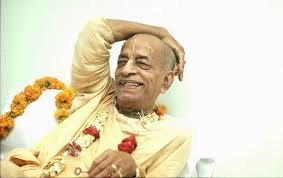To see the Lord, Part 6

" The atheist class men, they say, "Can you show me God?" There are statements of atheist class, or sannyāsī even, that he demanded his spiritual master "Whether you can show me God?" So God cannot be seen by such demand. In the śāstras it is said, ataḥ śrī-kṛṣṇa-nāmādi na bhaved grāhyam indriyaiḥ (CC Madhya 17.136). Śrī-kṛṣṇa-nāmādi. Śrī Kṛṣṇa is present by His name, by His form, by His pastimes, by His paraphernalia, by His qualities. Anything about Kṛṣṇa is non-different. Kṛṣṇa and Kṛṣṇa's name, it is the same. There is no difference. In the materialistic view, there is difference between the substance and the name. Just like water. If you are thirsty, simply if I chant, "Water, water, water," it will not quench your thirst. You require the substance, water. So similarly, a, a person's photograph or a statue is different from the person. If there is a photograph of a ...